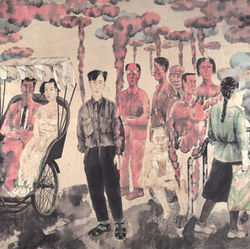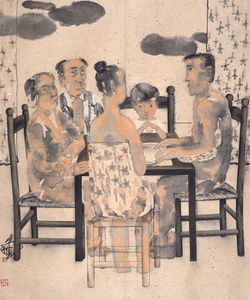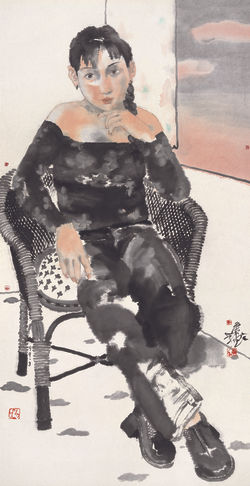Tang Contemporary Art is delighted to announce the launch of Liu Qinghe's eponymous exhibition, the most comprehensive and detailed large-scale academic exhibition of Liu Qinghe's work to date, to be held on March 9 at the Beijing 1st and 2nd Space. Curated by Cui Cancan, the exhibition adopts a multi-linear narrative structure and is divided into seven parts, comprehensively organizing the artist's artistic development from 1979 to the present. The exhibition spans 45 years, with over 200 works on display.
Liu Qinghe, a preeminent figure in contemporary Chinese ink art, is renowned for his contributions to the groundbreaking "New Generation" exhibition and the innovative concept of "Urban Ink." This exhibition, however, transcends a mere recounting of past achievements. It embarks on a captivating exploration of Liu's artistic odyssey spanning over four decades. We witness his relentless experimentation with artistic elements – grammar, themes, narratives, symbols, and metaphors – fueling his artistic evolution. Throughout his journey, his work has consistently resonated with and thrived within the ever-evolving landscape of contemporary art.
Unfolding across seven sections, the exhibition unveils Liu Qinghe's artistic journey. The opening section, "Monumental Ink Paintings and Manuscripts," lays the foundation with his signature polyphonic and multispatial narratives. We then shift focus to "Old Portraits of Two Families," where changes in era and theme showcase the artist's ability to narrate historical events through personal stories, embodying the concept of "small history." The exhibition takes a pivotal turn with Liu Qinghe's cross-media experimentation, highlighting his core pursuit of breaking boundaries and creating entirely new narratives using diverse media. Finally, the "Vernacular" series marks a bold departure from tradition. Here, Liu Qinghe embraces a completely new literary style, combining elements of diary entries, autobiography, and vernacular language, leaving behind the conventions of literati poetry, painting, and realism.
"New Urban, New Painting" marks a pivotal moment in Liu Qinghe's artistic journey. His groundbreaking works demonstrate the transformative potential of ink as a medium. In comparison to contemporaneous media, the unique sensations ink provides accurately capture the urban illusion, fundamentally touching upon the "era sentiment" specific to that time.
In over 40 years of artistic endeavors, Liu Qinghe has never rested on his laurels. "Temporal Estrangement" presents the artist's continuous self-renewal, a faithful representation of reality. Yet, he consistently employs new languages and methods to capture the ongoing occurrences in his surroundings. In the final section of the exhibition, we have chosen works from different periods of Liu Qinghe's career to retrospect, aiming to unveil the artist's worldview and philosophy concealed behind his creations.
Liu Qinghe's artistic journey reveals several defining characteristics. His groundbreaking "Urban" series fundamentally reshaped the language and concepts of contemporary art. He consistently pushes boundaries, exploring diverse mediums while maintaining ink painting as a vital force in contemporary practice. Through his "unique personal accent," Liu Qinghe constructs fresh narrative structures within his paintings, utilizing the vernacular. Underlying it all is a steadfast commitment to realism, evolving from symbolism to metaphor, and from the traditional literati artist to the modern individual.
Liu Qinghe's artistic odyssey, spanning over four decades, offers a valuable lesson. Throughout his career, he has consistently embraced transformation and open-mindedness, relentlessly pushing boundaries through experimentation. This relentless pursuit has seen him suspend the internal conflicts of ink, abandon the safe yet conventional territories, dare to make mistakes and pursue the avant-garde. In doing so, he dares to treat "ink" as a verb, a dynamic force for artistic exploration, rather than a static noun. This spirit of exploration, not just by Liu Qinghe but by his generation as a whole, has been instrumental in driving a remarkable cognitive shift in China over the past 40 years. The question has evolved from "What is ink?" to a far more transformative "What can ink be?"
This confirms a timeless truth: the embrace of "openness" and the relentless pursuit of the "avant-garde" are vital forces that propel us forward, regardless of the times.
 Near the PondInk and Wash on Paper 360×670cm 2006 |  Mother And SonInk and wash on paper 170×90 cm 1993 |  GameInk and wash on paper 160×100cm 1993 |
|---|---|---|
 SaturdayInk and wash on paper 100×100cm 1992 |  BreathInk and wash on paper 180×140cm 2001 |  Smoke - CloudInk and wash on paper 190×180cm 1993 |
 LunchInk and wash on paper 127×90cm 1992 |  HelpmateInk and wash on paper 175×95cm 1992 |  1931Ink and wash on paper 55×65cm 2014 |
 Portrait of Qiong FeiInk and wash on paper 132x68cm 1999 |  BeginnerInk and wash on paper 235×180 cm 2002 |  BurnInk and wash on paper 235×180 cm 2001 |
Artist

Liu Qinghe
Liu Qinghe was born in 1961 in Tianjin. China. He received degrees from the Tianjin School of Arts and Crafts in 1981, and the Folk Art Department at the Central Academy of Fine Arts in 1987. he received his master’s degree from the Chinese Painting Department at the Central Academy of Fine Arts in 1989. He studied at the Academy of Fine Arts at the Complutense University of Madrid in 1992. He is currently a professor, graduate adviser of the School of Chinese Painting at the Central Academy of Fine Arts.
Liu Qinghe has held solo exhibitions at the National Art Museum of China, Minsheng Art Museum, Shanghai Museum, Power Station of Art, Powerlong Museum, Guangdong Art Museum, Xiangning Art Museum, Shenzhen Art Museum, Zhejiang Art Museum, Shandong Art Museum, Nanjing Museum, He Art Museum, Beijing Fine Art Academy Museum, Song Art Museum, Today Art Museum, Shenzhen Guan Shanyue Art Museum, the University Museum and Art Gallery at the University of Hong Kong. He has also participated in group shows at Grand Palais, Paris, France; Saatchi Museum, London; Museum of Modern Art, Hamburg Railway Station, Berlin; Goppingen Museum, Germany; Rijksmuseum Berlin, Germany; Chasson Museum, USA; MUMOK Museum of Modern Art, Vienna, Austria; Condduk Palace, Madrid, Spain; Debrecen Museum, Hungary; National Museum of Australia; Geelong Museum, Australia; Mexico Tamayo Museum of Modern Art, Curitiba Museum in Brazil, Fukuoka Asian Art Museum in Japan, Tokyo University of the Arts in Japan, National Gallery of Malaysia. He was named Ink Artist of the Year at the Eighth AAC Awards, and he won the Shanghai Securities News Annual Golden Artist Prize. L’Officiel Art named him Ink Artist of the Year in 2013. His work has been added to important private and institutional collections around the world.
Curator

Cui Cancan
Cui Cancan, writer, curator.



